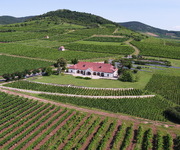There are only few wine regions in the world, where there are so much, moreover characteristically so different wine and wine category exists. This is why we say, that the Tokaji wine region doesn’t only depends on the place of production, but on the (in a large extent) classification of the product as well. We can classify the wines into three categories.

1. Varietal Wines
Furmint
It is very pleasant and nice in itself, but occasionally the producers make a wine of very firm acids out of this variety. Undoubtedly the Furmint is the dry wine of the region. Diverse versatile and enjoyable. In the steel containers we can produce fresh, and in the barrels “big”, full-bodied Furmint out of it. The “big” Furmint wine are made from the selected grape of several wineries, for which we have to harvest the riped grapes. This is one key element for the Furmint making, but additionally we can obtain an even more unique character with the use of yeasts.
Hárslevelű
The Hárslevelű wine is perhaps somewhat more stable, and we can find a very subtle linden-blossom scent in it, but even the biased Tokaji wine makers considering it a little bit one-dimensional. But the Hárslevelű-wines can evolve into a smooth, silky wines, but aging a bit sooner than its sibling-wine. They are not fond of the longer agings.
Yellow Muscat
Its wine have a very characteristically muscat scent and flavor. They produce fewer of it, but it’s a really exciting, full-bodied wine with smooth acids. Not easy to make a nice wine out of it, and the risk is bigger in the loess soil. It can be consumed fresh. Its wine gaining more and more popularity, mainly the sweet variants, that made with higher sugar content. Its relevance on the market is also great, because even though it can only be offered to a narrow customer base, it is a decisive, indispensable product of gourmet wine market. The particularly unique scent makes the wine easily distinguishable.
Zéta
Its wine is fragrant and thick. Usually a few sugar is remaining, but according to the experiences so far, it softens early. Because of the Bouvier-grape every now and then a bitter flavor remains in it, therefore there is a high probability, that its outstanding aszú-producing base wine will not appear independently in the market, although it can be good companion for the Furmint variety. They don’t make dry wine out of it, but its late harvest wine is excellent.
Kövérszőlő
Its wine is slightly fragrant, flavoursome, but it’s softer than the current main varieties. The producers use it with blending. Better results can be expected, if it is planted on a dry, thin soil, especially if the plants, that sensitive to the pressure are contained. Although we have to perform a lot of experiments on the wine of Kövérszőlő, it’s is already certain, that good and promising wines can be made out of it. It is possible, that the wine enthusiasts with time will be able to meet more Kövérszőlő wine on the market.
Kabar /Tarcal 10/
New variety, new possibilities. Lack of knowledge, but promising experiments. Its late harvest wine is promising.
Cuvée
In the Tokaj wine region the cuvées, or the blended wines are made in a different variety-composition. The different varieties possess different attributes, and the winers can balance this with variety ratios. Therefore in the cuvée we don’t have to look for the characteristic of the varieties, but the unique flavorful of the aromas, that signifies the cuvée as a whole. Thus the Tokaji cuvée wines have a great potential, and needs further experimenting. Arguing against these wines is that it is less Tokaji, so it is a newer category that hard to associate with the Tokaji characteristic and introduced to the market.
2. Wine specialties
This word refers to the wines, that were formed in the Tokaj wine region throughout its history. They made with a really unique procedure, which used nowhere else, and they have an appearance and name that signifies this wine region only. The wine specialties could contain all the varieties of the wine region. Recently appeared with a great product number, that exceeds the limits of experimenting, the promising “muscat aszú”, which bottles only the nectar of the muscat lunel variety.
Dry Szamorodni
One of the most sensitive wine, it is hard to make a good one, but if it succeeds, it’s a very delicious beverage. Nice and rich scent, wonderful acids, and the “walnutlike” wine makes it special. It’s an aperitif, but it’s also perfect for a “kvaterka-wine” (wine drinking during friendly conversation). It has found its place better in the field of gastronomy, the consumers know better when and with what kind of food worth to consume it, as in the case of sweet szamorodni. Recently it has started to gain its original place in the wine market. Its presence within the wine region is not equally traditional. For instance Tállya is one of the finest szamorodni producing district.
Sweet Szamorodni
It is a very hard genre for the wine producer and for the consumers alike. The category of sweet late harvest wines, the 3-puttony aszú wines, and the sweet szamorodni wines in respect of aroma and flavor complexity are very similar and sometimes even overlap each other. The wine merchant and the consumer can feel this similarly, thus the above mentioned wines in some cases can substitute or replace each other. The sweet szamorodni reaching the expenses of aszú-making, but the result is not yet an aszú wine. The delicious sweet szamorodni is very pleasant but because of it’s falls into a transitional category, it's hard to find the technological and market ratios. The most successful sweet szamorodnis are the ones, which made with less sugar content, but one can unmistakably detect the aszú nature. The aging is riskier, due to the lower sugar content.
3.Aszú
5-puttony aszú
The 5-puttony aszú is the hallway for the highest category. The 5-puttony aszú, that has a certain harmony, in spite of its lower sugar content, can rival with the some of the 6-puttony aszú. One of the most desired classic aszú-category, with significant sugar content and botrytis traits.
6-puttony aszú
The peak of aszú wine. The richest wine, that made with the most “stuff”, where the realized harmony in spite of the richness ( or even because of the richness) has made the wine easily enjoyable. The deepening colours give richness to the aromas and flavours. The 6-puttony aszú typically serve to maximize the added values. This is the category, where the winer attempt to get the most out of the variety, the ridge, and even himself.
Aszú essence
Very hard category for the market. The people sometimes mistaking it for the Essencia, but that is by definition a nectar, while here we talking about a very high quality wine. Further difficulty is, that the consumer can’t really catch the meaning of a category above 6-puttonys. Thus it’s not too common wine, the winers make just a few, because they can reach the highest market value with the 6-puttony aszú wines.
Tokaji máslás
It has a sweet and dry variant. The border between them is at 10g/l sugar content. Its colour usually light or amber yellow. The scent similar to the aging-fragrances of the other Tokaji wines. There are only a few are sold in the ordinary course of trade.
Tokaji fordítás
Just like in the case of máslás, the border between the sweet and dry fordítás is at 10g/l sugar content. Its scent- and aroma sensation is similar to the máslás. Rarely and just a few made for the market.
Essencia (nectar)
Unique, special, mystical natural treasure, concentrated energy, that made without technology, without it being spoiled by man. It isn’t a beverage, for it is so dense, that is only suitable for tasting. Obviously just a few are sold, although only a few are bottled. If anybody tasting it – and a Hungarian should taste it at least once in their life – will understand the aszú wines better. Mainly because he will be able to imagine the richness that the aszú wines are contain, but here in a less alcoholic and acidic atmosphere. Its technological value is that after the fermentation the winers adding essencia to the aszú wines. The significance of essencia is on the preservation of sugar content.








